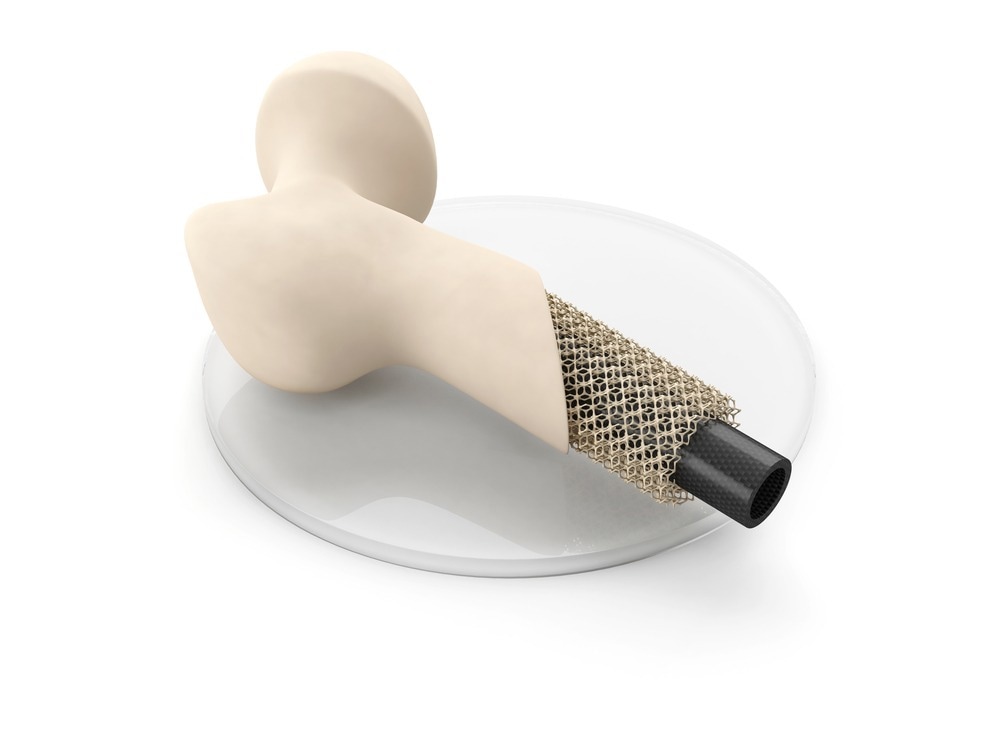Graphene has found widespread applications in the field of bone tissue engineering due to its favorable physical and biological properties. Additionally, the unique properties of graphene, including high surface area and surface functionalization flexibility, make it a potential candidate for applications in bone tissue engineering.

Study: Bovine serum albumin-functionalized graphene-decorated strontium as a potent complex nanoparticle for bone tissue engineering. Image Credit: Iaremenko Sergii/Shutterstock.com
An article recently published in Scientific Reports discussed a novel method to synthesize and decorate strontium (Sr) nanoparticles on the surface of graphene oxide (GO) via a reduction process using bovine serum albumin (BSA) for their applications in bone tissue engineering.
The obtained nanosheets were characterized using ultraviolet-visible (UV-Vis), Fourier transforms infrared (FTIR) spectroscopy, X-Ray diffraction (XRD), and Raman spectroscopy techniques, and the results demonstrated that BSA could successfully reduce GO facilitating the decoration of Sr nanoparticles on the reduced GO (rGO).
The field emission scanning electron microscopy (FESEM) and transmission electron microscopy (TEM) confirmed that the strontium nanoparticles had a diameter range of 25 to 30 nanometers. Moreover, the MC3T3-E1 cells showed higher cell viability when treated with strontium nanoparticles based on rGO nanosheet compared to those treated with GO and BSA-rGO in constant concentration.
Furthermore, alkaline phosphatase activity (ALP) of Sr nanoparticles based on BSA-rGO nanosheets was higher than GO and BSA-rGO. The expression of Col1 and RUNX 2 genes of MC3T3-E1 cells increased when treated with Sr nanoparticles based on BSA -rGO nanosheets. Thus, the present study demonstrated that Sr nanoparticles based on BSA -rGO nanosheets could regenerate tissues in bone tissue engineering.
Nanomaterials for Bone Tissue Engineering
The bone tissue engineering field came into the limelight nearly three decades ago. There has been tremendous progress in bone tissue engineering with exponentially increasing research. Bone tissue engineering focuses on alternative treatment options to eliminate issues of clinically used treatments such as donor site morbidity, limited availability, immune rejection, and pathogen transfer.
Bone tissue engineering requires the collaborative efforts of scientists, engineers, and surgeons to achieve this goal of creating bone grafts that enhance bone repair and regeneration. Advancements in nanotechnology have led to the development of various novel nanodevices and nanosystems based on the design and integration of functionalized nanomaterials.
To this end, graphene family derivatives are used to fabricate synthetic nanobiomaterials. The GO nanosheets are the hydrophilic version of graphene sheets consisting of sp2 hybridized carbon atoms. On the other hand, rGO is biocompatible with high reaction sites and minimal toxicity and can exhibit increased osteogenic capacity, which is crucial in bone tissue engineering.
The large surface area of graphene nanosheets facilitates the synthesis of Sr nanoparticles on the graphene surface by simultaneous reduction of GO and Sr nanoparticles. Moreover, previous studies demonstrated that Sr nanoparticles based on BSA -rGO nanosheets could be used in bone tissue engineering due to enhanced graphene strength.
BSA‑Functionalized Graphene‑Decorated Sr Nanoparticles for Bone Tissue Engineering
In the present work, simultaneous BSA-based reduction of GO and Sr nitrate resulted in graphene nanosheets decorated with Sr nanoparticles, which can be applied in bone tissue engineering. In these nanosheets, Sr nanoparticles were decorated on the surface of rGO nanosheets, and BSA used for reduction acts as a steric hindrance in blocking the rGO nanosheets restacking after reduction.
The presence of the Sr nanoparticles on rGO’s surface was confirmed using different methods. Since ALP is an important factor in bone tissue engineering, the effect of Sr nanoparticles based on BSA-rGO nanosheets on osteoblast cell line proliferation and ALP activity was studied to understand the potential of the prepared nanosheets. Moreover, COL1 and RUNX2 gene expressions were confirmed using a real-time polymerase chain reaction (PCR).
The UV-vis spectrum showed the characteristic peaks of GO at 225 and 310 nanometers that attributed to π-π and n-π interactions, respectively. Moreover, in rGO, the peak at 232 nanometers shifted to 260 nanometers, and the intensity of the peak at 310 nanometers decreased significantly.
The FTIR spectra of GO showed peaks at 3386-, 1728-, and 1615-centimeter inverse corresponding to hydroxyl (O–H), carbonyl (C=O), and alkene (C=C) bonds. Peaks at 1050 and 1224 centimeter inverse correspond to C–O stretching vibration while the peak at 1376-centimeter inverse corroborated the C–O deformation vibration.
On the other hand, rGO FTIR spectra showed a peak at 630-centimeter inverse corresponding to blending vibration of amide (O=C–NH) that corroborates the binding of BSA with GO compound. A new peak at 2850-centimeter inverse corresponds to C–H stretching vibrations in BSA methylene functional group.
Conclusion
To summarize, a facile approach toward BSA-mediated synthesis of Sr nanoparticle-decorated rGO nanosheets was demonstrated for their application in bone tissue engineering. Raman, UV–Vis, XRD, and FTIR spectroscopy results confirmed the role of BSA in reducing and decorating the Sr nanoparticles on the rGO nanosheet’s surface.
Furthermore, the FESEM and TEM images confirmed the deposition of Sr nanoparticles on BSA-rGO. The ALP activity, which is an important factor for bone tissue engineering, was higher in MC3T3-E1 cells treated with Sr nanoparticles based rGO nanosheets than in BSA-rGO and GO.
Moreover, Sr nanoparticles based on BSA-rGO nanosheets showed better cell viability than BSA-rGO and the GO via 3-[4,5-dimethylthiazol-2-yl]-2,5 diphenyl tetrazolium bromide (MTT) assay. Thus, the present work demonstrated a new approach for the application of nanomaterials in the field of bone tissue engineering.
Reference
Akbari, H., Askari, E., Naghib, S.M., Salehi, Z. (2022) Bovine serum albumin-functionalized graphene-decorated strontium as a potent complex nanoparticle for bone tissue engineering. Scientific Reports. https://www.nature.com/articles/s41598-022-16568-7
Disclaimer: The views expressed here are those of the author expressed in their private capacity and do not necessarily represent the views of AZoM.com Limited T/A AZoNetwork the owner and operator of this website. This disclaimer forms part of the Terms and conditions of use of this website.